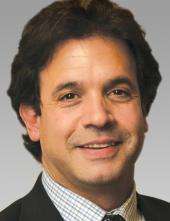Alzheimer’s Expert Jams with Aerosmith
 One of the world’s leading Alzheimer’s researchers doubles as a guest organist for Aerosmith.
One of the world’s leading Alzheimer’s researchers doubles as a guest organist for Aerosmith.
Rudy Tanzi, Ph.D., the Kennedy professor of neuroscience at Harvard, hit it off with lead guitarist Joe Perry on a photo shoot for men’s fashion magazine GQ, and the scientist, who is an expert on how beta amyloid accumulates in the brain, has since played with the band on a number of special occasions, CNN reported.
“It’s been such fun,” Tanzi said in an interview with CNN.
Tanzi is director of the Genetics and Aging Research Unit in the MassGeneral Institute of Neurodegenerative Diseases at Massachusetts General Hospital, and was at the forefront of the 1986 discovery of a gene associated with formation of the amyloid protein that starts to build up in the brain in Alzheimer’s disease. He credits the time spent mapping genes on early-morning bus rides and watching Love Boat, as part of his first major scientific break — the mapping of chromosome 21, and finding a gene for Huntington’s disease.
In the early 1980s, he would shuffle between late-night rock gigs, and early-morning bus rides to James Gusella’s lab at Massachusetts General Hospital in Boston. Gusella was one of the first to figure out how to map the genes of a disease, with his use of DNA sequence polymorphisms as genetic markers.
“Jim Gusella and I were just kids in our 20s, trying to figure it all out,” Tanzi told CNN. “Back then before genetics became a real industry, you had to jerry-rig everything. To take pictures of DNA I brought in a Polaroid camera my father gave me for my 13th birthday and I’d put it on a ring stand and I took the red acetate we would use from the light show for my band and put it in the lens. I’d take some of the maps from the dermatology labs to light up the DNA. That was the humble beginning of the human genetics revolution.”
Tanzi would spend his bus rides working on building a full map of a chromosome, by hand without the help of a computer program. The tedious work paid off and helped to usher in new understanding of the mechanics behind Huntington’s.
“I would sit there with these huge family trees on my papers and I would track genetic markers and I would know who had the disease in the family and who didn’t,” Tanzi said.
After he switched his work to focus on Alzheimer’s, the disease hit close to home when his grandmother began coming down with tell-tale symptoms. Tanzi said he became even more inspired to work harder and faster after personally seeing what the disease could do.
Again his work paid off with the discovery of a gene related to Alzheimer’s. Three other groups also found the gene over the same summer, and all published papers in February 1987. It was still a good moment, Tanzi told CNN, “It meant finally now we have a target for drug discovery.”
Despite two largely failed ‘waves’ of Alzheimer’s drug trials, Tanzi remains optimistic that a third one coming up in the next few years could turn the tide.




